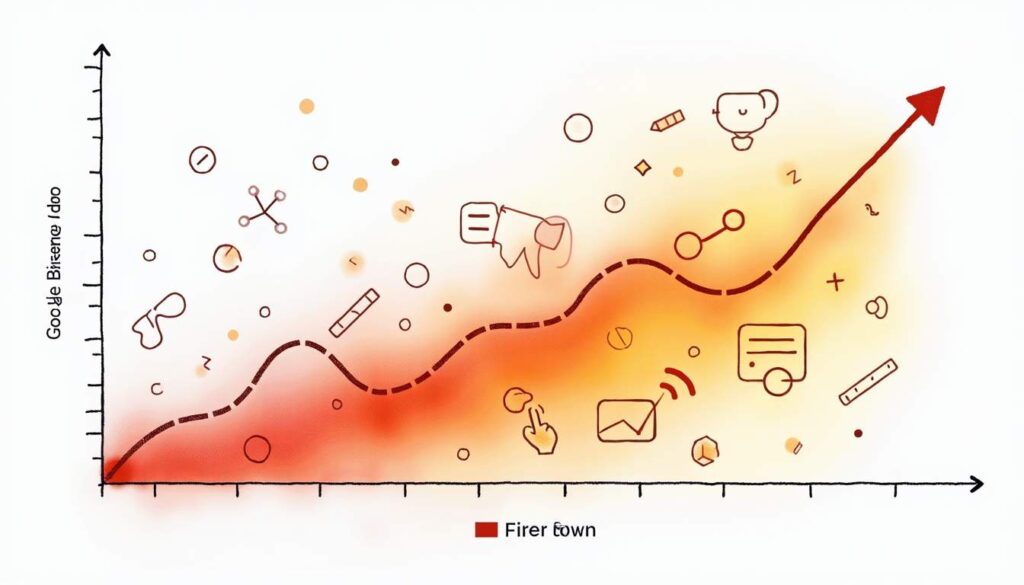Table of Contents
- What Are Heatmaps and Why Do They Matter?
- Boosting Conversions with Heatmap-Driven Optimizations
- Integrating User Behavior Analysis into Your Google Ads Strategy
- Challenges and Considerations When Using Heatmaps
- Practical Tips for Getting Started with Heatmaps and Google Ads
- Conclusion: Unlocking the Full Potential of Google Ads with Heatmaps
In the fast-paced world of digital marketing, understanding exactly how users interact with your website is crucial to maximizing the effectiveness of your Google Ads campaigns. Heatmaps and user behavior analysis have emerged as powerful tools that provide marketers with deep insights into visitor engagement, enabling smarter optimization and better conversion rates.
This article dives into how heatmaps can be leveraged alongside Google Ads to boost performance, improve user experience, and ultimately increase conversions. Whether you’re a seasoned marketer or just starting out, understanding these techniques can transform your advertising strategy.
What Are Heatmaps and Why Do They Matter?
Heatmaps are visual representations of user activity on a webpage, showing where visitors click, scroll, or hover most frequently. By highlighting “hot spots” of engagement and areas that get overlooked, heatmaps reveal how users truly interact with your content. This data is invaluable for understanding user preferences and behaviors, allowing businesses to make informed decisions about their digital strategies.
Unlike traditional analytics that provide raw numbers, heatmaps offer an intuitive, visual way to comprehend user behavior. This clarity helps marketers identify friction points, optimize layouts, and tailor content to meet user expectations. For instance, a heatmap can show that users are spending a significant amount of time on a particular section of a page, indicating that the content resonates well with them. Conversely, areas with little to no interaction may signal the need for a content overhaul or a more engaging design approach.
According to a recent industry report, e-commerce platforms utilizing heatmap tools experience a 35% improvement in user experience compared to those that don’t. This significant boost underscores how essential heatmaps have become for businesses aiming to refine their digital presence. Furthermore, heatmaps can also aid in A/B testing, allowing marketers to visualize the effectiveness of different layouts or content strategies, ultimately leading to more data-driven decisions that enhance user satisfaction.
How Heatmaps Complement Google Ads
Google Ads drives traffic to your site, but what happens once visitors arrive? Heatmaps help answer this by showing how users engage with landing pages, product listings, or sign-up forms. This insight is vital for optimizing the post-click experience — a key factor in conversion rate optimization. By understanding where users focus their attention, marketers can create more compelling experiences that align with user intent, thereby increasing the likelihood of conversions.
For example, if a heatmap reveals that users frequently click on a non-clickable image or ignore a call-to-action (CTA) button, marketers can adjust the design or placement to better capture attention. These refinements, guided by real user behavior, lead to higher engagement and more conversions. Additionally, heatmaps can expose trends over time, such as shifts in user behavior after a website redesign or a new marketing campaign, allowing businesses to adapt quickly and effectively to changing user needs and preferences. This continuous feedback loop ensures that marketing strategies remain relevant and effective in an ever-evolving digital landscape.
Boosting Conversions with Heatmap-Driven Optimizations
One of the most compelling reasons to use heatmaps is their proven impact on conversion rates. A study highlighted in LaninStar’s Marketing A to Z found that heatmap-driven optimizations led to a 25% increase in conversions across analyzed e-commerce sites. This is no small feat and illustrates the direct value heatmaps bring to digital marketing efforts.

By identifying exactly where users hesitate or drop off, marketers can remove obstacles and streamline the user journey. This targeted approach is far more effective than guesswork or relying solely on click-through rates from Google Ads.
Pinpointing Friction Points
Heatmaps reveal where users get stuck or confused. For instance, if visitors repeatedly click on an unresponsive element or fail to scroll down to important content, these are clear signals that something needs fixing. Addressing these friction points can significantly improve the overall user experience.
MEFMobile emphasizes that heatmap tools are pivotal in conversion rate optimization because they help businesses identify these exact friction points in the user journey that hinder conversions. Without this insight, marketers risk wasting ad spend by sending traffic to pages that don’t convert well.
Moreover, understanding user behavior through heatmaps allows for a more nuanced approach to A/B testing. Instead of merely testing different headlines or images, marketers can analyze user interactions to determine which elements are truly engaging or disengaging. This data-driven strategy not only enhances the effectiveness of A/B tests but also fosters a culture of continuous improvement, where insights gleaned from heatmaps inform ongoing design and content strategies.
Focusing on What Users Care About
Not all content on a page is equally important to visitors. Heatmaps help prioritize which sections or features get the most attention. UMA Technology’s research points out that heatmaps help teams focus on functionalities that users already demonstrate interest in, allowing for smarter allocation of resources and design efforts.
For Google Ads campaigns, this means you can align your landing page content with what your audience truly values, increasing the likelihood that clicks translate into meaningful actions. Additionally, by understanding user preferences and behaviors, businesses can tailor their messaging and offers to resonate more deeply with their target audience. This personalization not only enhances user satisfaction but also fosters brand loyalty, as customers feel more connected to brands that understand their needs.
Furthermore, the insights gained from heatmaps can guide the development of future content strategies. By analyzing which topics or products generate the most engagement, marketers can create targeted campaigns that speak directly to their audience’s interests. This proactive approach ensures that content remains relevant and compelling, ultimately driving higher engagement rates and conversions over time.
Integrating User Behavior Analysis into Your Google Ads Strategy
Understanding user behavior goes beyond just heatmaps. Combining multiple data sources provides a more comprehensive picture of how visitors interact with your ads and website. This multifaceted approach allows marketers to identify trends, preferences, and pain points, ultimately leading to more effective advertising strategies that resonate with target audiences.
Using Heatmaps with Analytics and A/B Testing
Heatmaps should be part of a broader optimization toolkit. Pairing heatmap insights with Google Analytics data and A/B testing allows marketers to validate hypotheses and measure the impact of changes systematically. By leveraging these tools, marketers can gain a clearer understanding of user engagement and conversion paths, transforming raw data into actionable insights.
For example, if a heatmap shows low engagement with a CTA button, you might test different colors, sizes, or text to see what resonates best with your audience. Over time, this iterative process refines your landing pages and ad targeting for maximum ROI. Additionally, analyzing user session recordings alongside heatmaps can provide qualitative insights, revealing the reasons behind user behaviors and preferences that numbers alone might not convey.
Behavioral Targeting and Personalization
Heatmaps also support behavioral targeting strategies by revealing patterns in user preferences and navigation paths. LaninStar’s Marketing A to Z highlights the importance of understanding consumer behavior nuances to develop effective marketing strategies. By recognizing these patterns, marketers can create user personas that reflect real-world behaviors, enabling them to craft messages that are not only relevant but also engaging.
By segmenting users based on their interactions and tailoring Google Ads messages accordingly, marketers can deliver more relevant ads that speak directly to user needs and interests. This level of personalization can significantly enhance user experience and increase conversion rates. Furthermore, integrating machine learning algorithms can automate the personalization process, allowing for real-time adjustments based on user interactions, which can lead to even greater engagement and retention. As consumers become increasingly accustomed to tailored experiences, the importance of leveraging behavioral insights in advertising strategies cannot be overstated.
Challenges and Considerations When Using Heatmaps
While heatmaps offer valuable insights, there are some challenges to keep in mind. Interpretation requires context — not every “hot spot” means a positive interaction, and some user behaviors might be misleading without additional data. For instance, a high concentration of clicks on a non-clickable element could indicate confusion rather than engagement. This highlights the importance of not relying solely on heatmaps for decision-making; they should be one part of a comprehensive analysis strategy that includes other metrics and qualitative data.

Additionally, heatmaps typically aggregate data, which can mask individual user journeys. This aggregation can sometimes lead to oversimplified conclusions about user behavior. Combining heatmaps with session recordings or user feedback can help fill in these gaps. By observing how users navigate through a site and understanding their motivations through direct feedback, businesses can gain a more nuanced view of user interactions, allowing for more targeted improvements.
Privacy and Data Concerns
With increasing focus on user privacy, marketers must ensure heatmap tools comply with regulations like GDPR and CCPA. Transparency about data collection and obtaining user consent are essential to maintaining trust. This means clearly communicating to users what data is being collected, how it will be used, and providing options for them to opt-out if they choose. Failure to do so not only risks legal repercussions but can also damage a brand’s reputation and user relationships.
It’s also worth noting that Google’s recent cancellation of the FLoC proposal in 2022 reflects ongoing shifts in how user data can be collected and used for advertising. As third-party cookies become less reliable, marketers must explore alternative methods for tracking and analyzing user behavior. Staying informed about these developments helps marketers adapt their strategies responsibly. Exploring privacy-centric analytics solutions or first-party data strategies can ensure that businesses remain compliant while still gaining valuable insights into user behavior. As the landscape evolves, the ability to pivot and innovate will be crucial for maintaining a competitive edge in digital marketing.
Practical Tips for Getting Started with Heatmaps and Google Ads
Ready to harness the power of heatmaps? Here are some practical steps to integrate heatmap analysis into your Google Ads workflow:
1. Choose the Right Heatmap Tool
Select a heatmap solution that fits your needs and budget. Look for features like click tracking, scroll maps, and integration with your existing analytics platforms. Popular tools such as Hotjar, Crazy Egg, and Mouseflow offer user-friendly interfaces and robust analytics capabilities, allowing you to visualize user interactions effectively. Additionally, consider tools that provide session recordings, as these can offer deeper insights into user behavior beyond what static heatmaps can show.
2. Analyze Key Landing Pages
Focus on pages receiving the most Google Ads traffic. These are critical touchpoints where optimization can have the greatest impact on conversions. By analyzing these key landing pages, you can identify which elements are performing well and which are not. For instance, if users are consistently scrolling past a call-to-action button, it may need repositioning or redesigning to enhance visibility. Understanding user flow on these pages can also help you create a more intuitive navigation experience, ultimately leading to higher engagement and conversion rates.
3. Identify and Prioritize Issues
Use heatmaps to spot areas of low engagement or confusion. Prioritize changes that address the biggest obstacles to conversion. Look for patterns such as unexpected drop-off points or sections of the page that users seem to ignore entirely. This data can guide your design decisions, such as simplifying forms or adjusting content placement. Additionally, consider conducting user surveys or feedback sessions to complement your heatmap data, providing qualitative insights that can further inform your optimization strategy.
4. Test and Iterate
Implement changes based on heatmap insights, then use A/B testing to measure their effectiveness. Continuous iteration is key to sustained improvement. Make sure to test one variable at a time to accurately gauge the impact of each change. For example, if you alter the color of a call-to-action button, track how this affects click-through rates compared to the original design. Document your findings meticulously, as this will help you build a repository of successful strategies and inform future campaigns.
5. Align Ads with User Behavior
Adjust your Google Ads targeting and messaging to reflect what you’ve learned about user preferences and behaviors from heatmaps. By tailoring your ad copy and visuals to resonate with your audience’s interests and pain points, you can enhance the relevance of your ads. For instance, if heatmap data reveals that users are particularly engaged with certain product features, highlight these in your ad campaigns. Additionally, consider segmenting your audience based on their interactions with your site to deliver personalized ad experiences, which can significantly boost click-through and conversion rates.
Conclusion: Unlocking the Full Potential of Google Ads with Heatmaps
Heatmaps and user behavior analysis offer a window into the real actions and preferences of your website visitors. When combined with Google Ads, these insights empower marketers to optimize landing pages, reduce friction, and create more personalized ad experiences.

With proven results like a 25% increase in conversions and a 35% improvement in user experience for heatmap users, it’s clear that this approach isn’t just a nice-to-have — it’s a game-changer. By embracing heatmaps as part of your digital marketing toolkit, you can make smarter decisions, maximize your ad spend, and deliver experiences that truly resonate with your audience.



